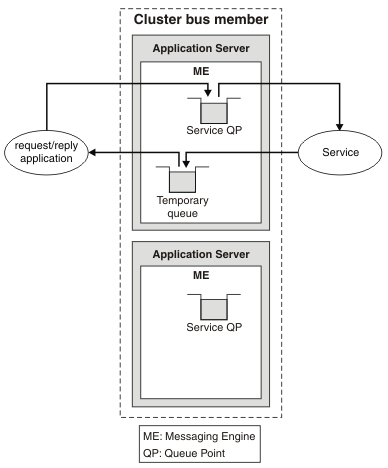Network Deployment (Distributed operating systems), v8.0 > Applications > Service integration > High availability and workload sharing > Workload sharing > Workload sharing with queue destinations > JMS request and reply messaging with cluster bus members
Use a temporary queue as a reply queue
JMS can create a temporary queue dynamically for use as a reply queue. We can use this to ensure that a reply message is sent to the appropriate queue point for a cluster bus member.
This temporary JMS queue uses a temporary service integration bus queue. Temporary service integration bus queues have only one queue point, irrespective of the number of messaging engines in the bus member. This queue point is created on the messaging engine to which the creating JMS application is connected. Figure 1. Temporary queue point on the local messaging engine for the requesting application

Therefore, for a cluster bus member with multiple messaging engines (typically, to provide workload management or scalability), you can use a temporary queue to avoid situations where reply messages are sent to the wrong queue point.
This approach has the following advantages:
- It is simple to use.
- No further configuration of the service integration bus or JMS system is required.
- If the JMS connections of a number of requesting applications are workload balanced across the messaging engines in a cluster bus member, the temporary queues are workload balanced across these messaging engines.
This approach has the following disadvantages:
- The reply queue is temporary. When the creating application closes the JMS connection, or the messaging engine is stopped, the reply queue, any messages on it, and any messages on their way to it, are deleted. Therefore, when the JMS application disconnects, it cannot reconnect later to receive the reply message.
Therefore, it is appropriate to use a temporary queue for a cluster bus member with multiple messaging engines only if it is acceptable to lose the reply messages if the application or system stops. If this approach is not acceptable, the following options allow applications to reconnect and process reply messages:
- Use a scoped service integration bus alias destination to restrict messages to a single queue point .
- Restrict reply messages to the queue point that is local to the requesting application.
- Configure the requestor to consume messages from all queue points simultaneously.
JMS request and reply messaging with cluster bus members